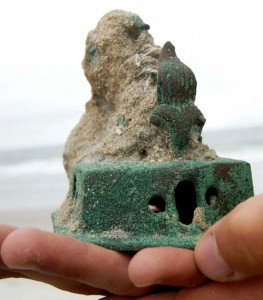A team of U.S. researchers and marine archaeologists from Mexico’s National Anthropology and History Institute (INAH) found a Chinese bronze sculpture from the 16th century on the Pacific coast of Baja California, a peninsula south of the US state of California. At just under five inches square, the statue is either a censer or a candlestick. It is decorated with a Chinese “Dog of Fo,” a lion figure that protected Buddhist temples.
 It was discovered under water using a metal detector two weeks ago as part of the ongoing 12-year Manila Galleon Project which surveys 7 miles along the Baja coast for the remains of Spanish ships known as the Manila Galleons, ships that carried trade cargo from the Philippines to Acapulco. The trade began in 1565 when Andrés de Urdaneta, explorer, Augustinian friar and the second man to circumnavigate the globe, discovered that if ships departing from Cebu City went north first, the Pacific trade winds would carry them east to the coast of California.
It was discovered under water using a metal detector two weeks ago as part of the ongoing 12-year Manila Galleon Project which surveys 7 miles along the Baja coast for the remains of Spanish ships known as the Manila Galleons, ships that carried trade cargo from the Philippines to Acapulco. The trade began in 1565 when Andrés de Urdaneta, explorer, Augustinian friar and the second man to circumnavigate the globe, discovered that if ships departing from Cebu City went north first, the Pacific trade winds would carry them east to the coast of California.
It was a punishingly long trip. Urdaneta lost most of his crew the first time, and even once the trade got going in earnest, the galleons took four months to sail from Manila to Acapulco. From there the cargo of spices, porcelain, ivory, silk and bronze devotional statues, etc., was transported overland to the Gulf of Mexico where it was added to the Spanish treasure ships heading back to the motherland. Tedious, long and dangerous as it was, this trip allowed Spanish ships to avoid using unfriendly foreign ports and the Portuguese routes in the Indian Ocean and around the Cape of Good Hope.
The find comes from one of the first galleons of the 16th century to set sail from Manila in the Philippines en route to Acapulco in the Viceroyalty of New Spain, INAH marine archaeology unit member Roberto Junco said.
The route “was the longest on the high seas…in this case the ship could have been carried off by the various currents along the coast of the Californias, with no survivors to continue the crossing,” Junco said.
The remains of the goods found probably belonged to the San Felipe galleon, which sailed carrying a large cargo of Chinese porcelain from the Ming Dynasty and which disappeared without a trace in 1576, maritime historian Edward Von der Porten said.
The Manila Galleon Project began when some of that Ming porcelain was discovered on a Baja beach in 1999. The surveys have found thousands of pieces of porcelain, chunks of beeswax, lead sheathing from the ship and other artifacts, but this is the first bronze “Dog of Fo” sculpture they’ve discovered. Jesuit missionary chronicles from the 18th century note on more than one occasion Indians having bronze candlesticks shaped like dogs. Perhaps they were describing something like this object traded from China off a Manila galleon.
It was an enormous market, starting with American silver which the Spanish shipped to the Far East. Historians estimate that as much as a third of all the silver mined in the Spanish colonies of America ended up in Asia. With that silver the traders bought goods to fill up their huge ships — the Manila galleons were built particularly large for cargo and so the crew could actually survive once in a while — and headed back to Mexico. On its way from Baja to the Gulf, some of the cargo would be sold and traded locally. You can see the influence of Asian porcelain and ivory in Mexican ceramics.
The Manila galleons finally stopped sailing in 1815 when the Mexican War of Independence against Spain broke the cycle.